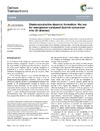Identificador persistente para citar o vincular este elemento:
https://accedacris.ulpgc.es/jspui/handle/10553/69280
| Campo DC | Valor | idioma |
|---|---|---|
| dc.contributor.author | Azofra Mesa, Luis Miguel | en_US |
| dc.contributor.author | Poater, Albert | en_US |
| dc.date.accessioned | 2020-01-23T12:56:13Z | - |
| dc.date.available | 2020-01-23T12:56:13Z | - |
| dc.date.issued | 2019 | en_US |
| dc.identifier.issn | 1477-9226 | en_US |
| dc.identifier.other | WoS | - |
| dc.identifier.uri | https://accedacris.ulpgc.es/handle/10553/69280 | - |
| dc.description.abstract | The proposed reaction mechanism for the unprecedented direct transformation of primary alcohols into alkenes catalysed by Mn(i)-PNP complexes consists of two cycles. First, the acceptorless dehydrogenation of the alcohol into aldehyde is produced via a concerted mechanism. Secondly, in an excess of hydrazine, hydrazone is formed and reacts with the aldehyde to produce olefins. This process, taking place in base-free conditions, is characterised by the diastereoselective formation of diazenyl intermediates. Based on DFT data, the generation of the (S-N,S,S) diastereoisomer is favoured over the rest, leading in its decomposition to the preferential formation of an (E)-alkene and liberating N-2 and H2O as the only by-products. | en_US |
| dc.language | eng | en_US |
| dc.relation.ispartof | Dalton Transactions | en_US |
| dc.source | Dalton Transactions [ISSN 1477-9226], v. 48 (37), p. 14122-14127 | en_US |
| dc.subject | 3303 ingeniería y tecnología químicas | en_US |
| dc.subject.other | Amines | en_US |
| dc.subject.other | Ligand | en_US |
| dc.subject.other | Approximation | en_US |
| dc.subject.other | Hydrogenation | en_US |
| dc.subject.other | Aldimines | en_US |
| dc.subject.other | Complexes | en_US |
| dc.subject.other | Oxidation | en_US |
| dc.subject.other | Nitriles | en_US |
| dc.subject.other | Energy | en_US |
| dc.subject.other | Form | en_US |
| dc.title | Diastereoselective diazenyl formation: the key for manganese-catalysed alcohol conversion into (E)-alkenes | en_US |
| dc.type | info:eu-repo/semantics/Article | en_US |
| dc.type | Article | en_US |
| dc.identifier.doi | 10.1039/c9dt03379c | en_US |
| dc.identifier.scopus | 85072588662 | - |
| dc.identifier.isi | 000487514400025 | - |
| dc.contributor.authorscopusid | 55142490200 | - |
| dc.contributor.authorscopusid | 8533443400 | - |
| dc.identifier.eissn | 1477-9234 | - |
| dc.description.lastpage | 14127 | en_US |
| dc.identifier.issue | 37 | - |
| dc.description.firstpage | 14122 | en_US |
| dc.relation.volume | 48 | en_US |
| dc.investigacion | Ingeniería y Arquitectura | en_US |
| dc.type2 | Artículo | en_US |
| dc.contributor.daisngid | 1089199 | - |
| dc.contributor.daisngid | 141031 | - |
| dc.utils.revision | Sí | en_US |
| dc.contributor.wosstandard | WOS:Azofra, LM | - |
| dc.contributor.wosstandard | WOS:Poater, A | - |
| dc.date.coverdate | Octubre 2019 | en_US |
| dc.identifier.ulpgc | Sí | en_US |
| dc.description.sjr | 1,048 | |
| dc.description.jcr | 4,174 | |
| dc.description.sjrq | Q1 | |
| dc.description.jcrq | Q1 | |
| dc.description.scie | SCIE | |
| item.fulltext | Con texto completo | - |
| item.grantfulltext | open | - |
| crisitem.author.dept | GIR IUNAT: Fotocatálisis y espectroscopía para aplicaciones medioambientales. | - |
| crisitem.author.dept | IU de Estudios Ambientales y Recursos Naturales | - |
| crisitem.author.orcid | 0000-0003-4974-1670 | - |
| crisitem.author.parentorg | IU de Estudios Ambientales y Recursos Naturales | - |
| crisitem.author.fullName | Azofra Mesa, Luis Miguel | - |
| Colección: | Artículos | |
Citas SCOPUSTM
19
actualizado el 08-jun-2025
Citas de WEB OF SCIENCETM
Citations
20
actualizado el 12-ene-2026
Visitas
71
actualizado el 10-ene-2026
Descargas
111
actualizado el 10-ene-2026
Google ScholarTM
Verifica
Altmetric
Comparte
Exporta metadatos
Los elementos en ULPGC accedaCRIS están protegidos por derechos de autor con todos los derechos reservados, a menos que se indique lo contrario.
